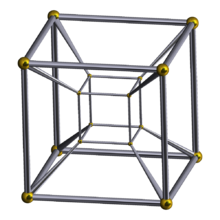tesseract
Appearance
English
[edit]

Etymology
[edit]From tessara- (“four-”) + Ancient Greek ἀκτίς (aktís, “ray”).
Pronunciation
[edit]Noun
[edit]tesseract (plural tesseracts)
- (mathematics, geometry) The four-dimensional analogue of a cube; a 4D polytope bounded by eight cubes (analogously to the way a cube is bounded by six squares).
- 1906, Charles Howard Hinton, The Fourth Dimension, S. Sonnenschein & Company, page 239:
- Hence the cube determined by these axes is the face of the tesseract which we now have before us.
- 1910, Henry Parker Manning, The Fourth Dimension Simply Explained, Munn, Incorporated, page 93:
- […] then it would trace out a higher cube, or tesseract, and each of the six surrounding cubes, carried on in the same motion, would trace tesseracts also, […] .
- (science fiction) Any of various fictional mechanisms that explain extradimensional, superluminal, or time travel outside the geometry of the physical universe.
- 1962, Madeleine L'Engle, A Wrinkle in Time, published 2019, unnumbered page:
- "I shall just sit down for a moment and pop on my boots and then I'll be on my way. Speaking of ways, pet, by the way, there is such a thing as a tesseract."
Synonyms
[edit]- (analogue of a cube): four-dimensional hypercube, 4-cube, 8-cell, octachoron, tetracube
Hypernyms
[edit]Derived terms
[edit]Related terms
[edit]Translations
[edit]four-dimensional analogue of a cube
|
Further reading
[edit] Tesseract on Wikipedia.Wikipedia
Tesseract on Wikipedia.Wikipedia  Tesseract (disambiguation) on Wikipedia.Wikipedia
Tesseract (disambiguation) on Wikipedia.Wikipedia - Tesseract on Wolfram MathWorld
